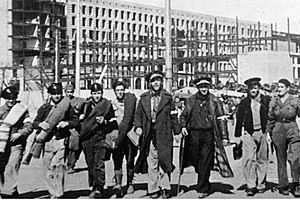| Spanish coup of 1939 | |||||||
|---|---|---|---|---|---|---|---|
| Part of Final offensive of the Spanish Civil War | |||||||
 Casadista troops in Madrid | |||||||
| |||||||
| Belligerents | |||||||
|
(Negrinistas) |
(Casadistas, CND) | ||||||
| Commanders and leaders | |||||||
|
Juan Negrín Luis Barceló Guillermo Ascanio Francisco Galán |
Segismundo Casado José Miaja Cipriano Mera Wenceslao Carrillo Julián Besteiro Manuel Matallana | ||||||
| Strength | |||||||
| Minority of army and administration | Majority of army and administration | ||||||
| Political support | |||||||
| Communists | Liberals, Anarchists, Socialists, Moderates | ||||||
| Casualties and losses | |||||||
| Unclear; KIA estimates range from 250 to 2,000 | |||||||
Spanish coup of March 1939, in historiography often referred to as Casado's coup (Spanish: Golpe de Casado), was a coup d'état organized in the Republican zone against the government of Juan Negrín. It was carried out by the military with support of the Anarchists and a major faction of the Socialists; its leader was commander of the Army of the Centre, Segismundo Casado. The conspirators viewed the Negrín government as a hardly veiled Communist dictatorship. Most concluded that the government-endorsed strategy of unyielding resistance against the Nationalists would produce nothing but further deaths and sufferings while the war had already been lost. The military and some politicians intended the coup as a first step towards opening peace negotiations with the Nationalists; for the Anarchists and Socialists the priority was to remove the Communists from power.
The coup began on March 5, when rebels declared the setup of their own quasi-government, Consejo Nacional de Defensa (CND), based in Madrid. Following few hours of discussions the Negrín government, at the time based near the town of Elda at the Levantine coast, decided that any resistance was pointless; the following day they left Spain. The rebels easily took control of all provincial capitals with very little or no fighting recorded. The exception was Madrid, where the local Communist executive, unaware of the PCE Political Bureau decision to avoid bloodshed, mounted resistance. Communist-controlled units recalled from the frontline took control of most of Madrid and on March 9 they were closing in on CND headquarters. However, Anarchist-controlled units also recalled from the frontline entered the city on March 10 and in 3 days they ensured the triumph of the rebels. During the next 3 weeks the Republican zone was ruled by the CND.